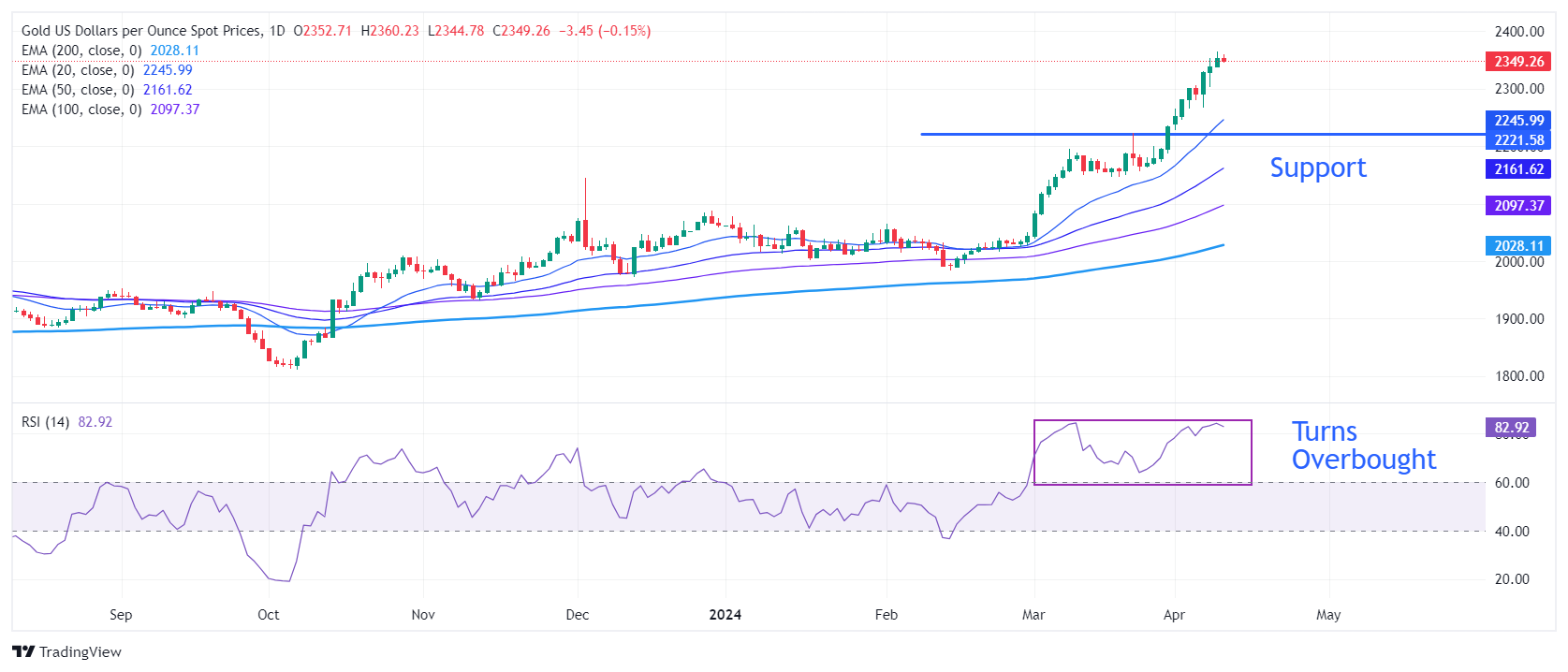- Gold price faces an intense sell-off on hot US inflation data for March.
- The US monthly headline and core CPI grew steadily by 0.4%.
- Escalating geopolitical tensions keeps the demand for Gold intact.
Gold price (XAU/USD) falls sharply from fresh highs of $2,365 in Wednesday’s early New York session as the United States Bureau of Labor Statistics (BLS) has reported a stubbornly higher Consumer Price Index (CPI) report for March. The inflation grew steadily on major parameters, while annual headline inflation accelerated further to 3.5% from expectations of 3.4% and the prior reading of 3.2%. Economists anticipated inflation to remain stubborn due to higher Oil prices, rentals, insurance costs and portfolio management fees.
Strong CPI data forced traders to shift bets on the Federal Reserve (Fed) beginning to reduce interest rates from the September meeting. This scenario bodes well for interest-bearing assets, such as US bonds and the US Dollar. 10-year US Treasury yields soar to 4.5%. The US Dollar Index (DXY), which values the US Dollar's strength against six major currencies, rallies to 105.00. Hotter-than-expected is expected to deepen uncertainty over the number of rate cuts by the Federal Reserve (Fed), which policymakers anticipated three times this year.
Generally, the Fed's longer-term maintenance of higher interest rates builds downside pressure on non-yielding assets such as Gold as it increases the cost of investing in them. Still, there has been an anomaly in Gold in the past few weeks, as its demand remained robust despite traders paring big bets on Fed rate cut prospects for the June and July meetings.
Daily digest market movers: Gold price falls sharply while US Dollar rallies
- Gold price drops vertically from fresh all-time highs of around $2,365 due to multiple headwinds. Stubbornly higher United States inflation data for March and strong payroll data combined with overbought momentum oscillators have put significant pressure on the Gold price. This has shaken investors’ confidence in the Federal Reserve reducing interest rates in the June and July policy meetings.
- US monthly headline and core CPI, which strips off volatile food and energy prices, both grew steadily by 0.4%. Economists forecasted them to grow slowly by 0.3%. The annual headline inflation rose strongly by 3.5% from expectations of 3.4% and the prior reading of 3.2%. The annual core inflation increased steadily by 3.8%. Investors anticipated it to decelerate slightly to 3.7%.
- Earlier, the precious metal has experienced a great bull run in the last few weeks. Gold has remained the talk of the town in the past few weeks due to a fresh escalation in Middle East tensions, which has firmed safe-haven bids and pent-up demand for precious metals by global central banks. Central banks piled up Gold inventory as a hedge against a potential economic slowdown.
- Fading expectations of a ceasefire between Israel and Palestine also keep Gold demand buoyant. The Israeli proposal of a ceasefire on April 9 didn’t match the demands from Hamas, which wants Israel to withdraw its forces and allow displaced Palestinians to return to their homes.
Technical Analysis: Gold price retreats from fresh highs around $2,360
Gold price falls sharply as the US inflation data turns out hot. The precious metal hovers near fresh lifetime highs around $2,360. The near-term demand remains intact as all short-to-long-term Exponential Moving Averages (EMAs) are still sloping higher.
On the downside, March 21 high at $2,223 will be a major support area for the Gold price bulls.
The 14-period Relative Strength Index (RSI) reaches 85.00, indicating a strong bullish momentum. However, extremely overbought signals could lead to a mild correction.
Fed FAQs
Monetary policy in the US is shaped by the Federal Reserve (Fed). The Fed has two mandates: to achieve price stability and foster full employment. Its primary tool to achieve these goals is by adjusting interest rates. When prices are rising too quickly and inflation is above the Fed’s 2% target, it raises interest rates, increasing borrowing costs throughout the economy. This results in a stronger US Dollar (USD) as it makes the US a more attractive place for international investors to park their money. When inflation falls below 2% or the Unemployment Rate is too high, the Fed may lower interest rates to encourage borrowing, which weighs on the Greenback.
The Federal Reserve (Fed) holds eight policy meetings a year, where the Federal Open Market Committee (FOMC) assesses economic conditions and makes monetary policy decisions. The FOMC is attended by twelve Fed officials – the seven members of the Board of Governors, the president of the Federal Reserve Bank of New York, and four of the remaining eleven regional Reserve Bank presidents, who serve one-year terms on a rotating basis.
In extreme situations, the Federal Reserve may resort to a policy named Quantitative Easing (QE). QE is the process by which the Fed substantially increases the flow of credit in a stuck financial system. It is a non-standard policy measure used during crises or when inflation is extremely low. It was the Fed’s weapon of choice during the Great Financial Crisis in 2008. It involves the Fed printing more Dollars and using them to buy high grade bonds from financial institutions. QE usually weakens the US Dollar.
Quantitative tightening (QT) is the reverse process of QE, whereby the Federal Reserve stops buying bonds from financial institutions and does not reinvest the principal from the bonds it holds maturing, to purchase new bonds. It is usually positive for the value of the US Dollar.
Information on these pages contains forward-looking statements that involve risks and uncertainties. Markets and instruments profiled on this page are for informational purposes only and should not in any way come across as a recommendation to buy or sell in these assets. You should do your own thorough research before making any investment decisions. FXStreet does not in any way guarantee that this information is free from mistakes, errors, or material misstatements. It also does not guarantee that this information is of a timely nature. Investing in Open Markets involves a great deal of risk, including the loss of all or a portion of your investment, as well as emotional distress. All risks, losses and costs associated with investing, including total loss of principal, are your responsibility. The views and opinions expressed in this article are those of the authors and do not necessarily reflect the official policy or position of FXStreet nor its advertisers. The author will not be held responsible for information that is found at the end of links posted on this page.
If not otherwise explicitly mentioned in the body of the article, at the time of writing, the author has no position in any stock mentioned in this article and no business relationship with any company mentioned. The author has not received compensation for writing this article, other than from FXStreet.
FXStreet and the author do not provide personalized recommendations. The author makes no representations as to the accuracy, completeness, or suitability of this information. FXStreet and the author will not be liable for any errors, omissions or any losses, injuries or damages arising from this information and its display or use. Errors and omissions excepted.
The author and FXStreet are not registered investment advisors and nothing in this article is intended to be investment advice.
Recommended content
Editors’ Picks

AUD/USD: Upside appears capped at 0.6300 on Trump's tariff fallout
AUD/USD struggles to build on the previous day's rebound and remains below the 0.6300 mark early Wednesday, anticipating US President Trump's tariffs announcement later in the day. However, buyers continue to draw support from China's stimulus optimism and RBA's prudence on the policy outlook.

USD/JPY holds losses below 150.00 as traders await Trump's tariffs
USD/JPY stays defensive below 150.00 in Wednesday's Asian trading as traders turn cautious ahead of Trump's reciprocal tariffs announcement. A cautious market mood and BoJ Ueda's comments underpin the Japanese Yen, keeping the pair under pressure amid a subdued US Dollar.

Gold risks a sharp pullback if Trump’s ‘reciprocal tariffs’ disappoint
Gold price regains traction on ‘Liberation Day’, having found fresh demand near the $3,110 region. The further upside in Gold price hinges on the highly anticipated US President Donald Trump’s “reciprocal tariffs” later this Wednesday.

Solana traders risk $120 reversal as FTX begins $800M repayments on May 30
Solana’s price remained pinned below $130 on Tuesday, despite a broader market recovery. While Bitcoin, Ripple, and Cardano posted gains exceeding 3% over the past 24 hours, SOL lagged behind.

Is the US economy headed for a recession?
Leading economists say a recession is more likely than originally expected. With new tariffs set to be launched on April 2, investors and economists are growing more concerned about an economic slowdown or recession.

The Best brokers to trade EUR/USD
SPONSORED Discover the top brokers for trading EUR/USD in 2025. Our list features brokers with competitive spreads, fast execution, and powerful platforms. Whether you're a beginner or an expert, find the right partner to navigate the dynamic Forex market.


